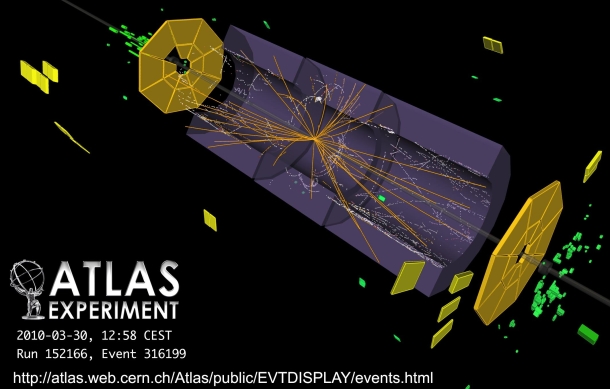LHC's high-energy physics research takes off

The Large Hadron Collider has successfully collided two beams at the highest energy ever for a particle accelerator, allowing scientists at Cern to begin their research into new physics.
Shortly after 1pm on Tuesday in Geneva, the LHC reached 3.5 tera-electron volts (TeV) per proton beam, after Cern fixed two glitches that had held up the experiment. The two beams were then successfully collided to produce experimental data at 7 TeV.
"This means major excitement," said Oliver Buchmueller, who organises physics searches at the CMS detector. "Today, we've entered a new era in particle physics."
All four of the detectors in the LHC successfully detected collisions, said Buchmueller. The detectors, found at different points around the 27km LHC circuit under the French-Swiss border, are Atlas, CMS, LHCb and Alice.
Buchmueller said the next step is for Cern to run the LHC continuously for up to two years to gather and exploit data for a range of physics researches.
Scientists will begin by finding known particles as a run-up to starting a systematic search for the Higgs boson, a hypothetical scalar elementary particle also known as the 'God particle', Cern said in a statement. Research will also cover antimatter, dark matter, the possible presence of extra dimensions, and other fundamental physics.
Physicists will begin by increasing the intensity of the beams. On Tuesday, the detectors were picking up 20-30 events per second, due to the number of bunches of protons being fired at each other. On Tuesday, two bunches of protons were being fired at each other, but this total will increase by steps — up to 2,700 bunches, said Buchmueller.
Buchmueller is one of the scientists at Cern involved in the search for dark matter and for super-symmetry. Dark matter effectively could weakly interact with other forms of matter, he said, adding that an energy of 3.5 TeV per beam may be enough to study dark matter.
Cern, which is funded by EU members among other countries, had been working towards the 3.5 TeV goal for years, said Steve Myers, director for accelerators and technology at the European organisation.
"We're all very relieved, totally excited," said Myers. "I was confident, but there's many a slip twixt cup and lip."
